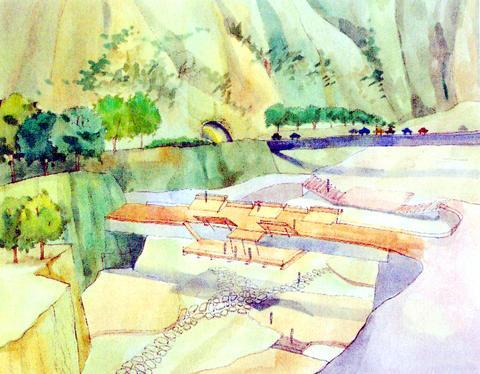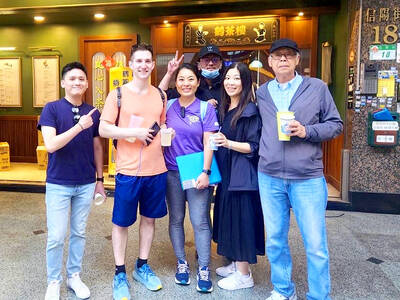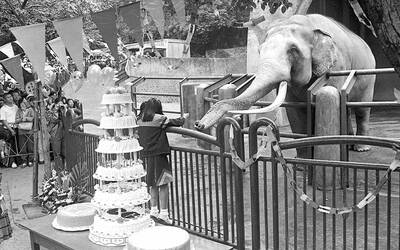Making better use of the tourism resources across Taiwan, the Tourism Bureau of the Ministry of Transportation and Communications (交通部觀光局) has launched the "2008 Doubling of Tourist Arrival Plan" (2008 觀光客倍增計畫) to promote tourism as one of the country's major industries.
Some 2 million tourists visited Taiwan last year, bringing in foreign exchange of US$4.197 billion, according to the ministry. The program is aimed at attracting over 5 million tourists in six years.

PHOTO COURTESY OF DIALOGUE
One of the major projects in the six-year plan is "New Taiwan by Design International Competition," which is intended to give the most-visited tourist destinations a makeover to increase their appeal. In the preliminary selection which ended last week, architects here and abroad have been competing for contracts to design the Fenchihu train station in Alishan mountain (阿里山奮起湖車站), the Water Activity Park (親水公園) and Scenic Area Administration Building (風景管理中心) at Sun Moon Lake (日月潭), Fuchi Harbor (富基漁港) and Padouzi Harbor (八斗子漁港) on the Northeast Coast are and Tropical Botanical Garden (熱帶植物園) and its surrounding in Hengchen Peninsula (恆春半島).
The Tourism Bureau has earmarked NT$1.65 billion for the construction of these projects.
Following the "Landform Series" of improvements will be the "Gateway Series" of upgrades under the "New Taiwan by Design" program, which will be launched within months to enlist designs to give transportation hubs, such as CKS Airport (中正機場), Taipei Main Station (台北車站), Keelung's Ocean Plaza (基隆海洋廣場) and Kaohsiung's Starlight Harbor (高雄星光碼頭) a facelift.
The bureau is still working on selecting the tourist destinations to include in the third and final part of the program.
"New Taiwan by Design" is the most high-profile international architecture design competition since the Taipei City Government Bureau of Urban Development's design competition of Capital Plaza in 2001, which enlisted designs for the space in front of the Presidential Office to be carried out if there was reconstruction of the space in the future.
"While the Capital Plaza project is more conceptual, `New Taiwan by Design' will really carry out the winning designs. It has dealt with land ownership and other practical issues. It's also been guaranteed with a solid budget. There's also a clear timetable. These projects will definitely be carried out," said Chin Guang-yu (金光裕), editor in chief of the architectural magazine Dialogue (建築雜誌), a co-executor of the program.
After the results of the
competition come out in November, the Tourism Bureau is scheduled to sign design contracts with the winning architects in December. "Contracting for the construction is scheduled to start early next year, and by the end of 2005 we should see the new buildings on these locations," Chin said.
Lin Sheng-feng (林盛豐), organizer of the competition and convener of the jury composed of eight architects from Malaysia, the US, the Netherlands, Japan and Taiwan, expects this new international-level architecture to help the development of the selected tourist spots.
"The quality of a tourist spot depends on both private investments and public infrastructure. What we are trying to provide are public buildings whose architecture is above an international level, which we hope would then encourage the private sector to invest in these tourist spots in the future," Lin said.
"In the past, tourist attractions were not on the top of the list of the government's construction projects, while industrial and technology constructions were. That's why we see science parks exhibiting top-notch well-designed exteriors. But finally tourism, especially international tourism, has become top of the government agenda now.
"The winning designs should be those able to integrate the resources of the respective tourist spots into a harmonious whole and thereby transform the currently randomly planned scattering of buildings in most tourist spots," Lin said.
The fact that some of the projects, such as Fuchi and Padouzi harbors, include open spaces as well as other buildings, offers challenges for both the competitors and the jury.
"The competition is unprecedented in combining aspects of tourism, landscape, design and environmentalism. The architects have to design more than just nice buildings," said Han Pao-de (漢寶德), director of the Museum of World Religion (世界宗教博物館) and one of the judges.
The jury is looking for designs that are able to find a balance between local flavor and styles which have a cross-cultural appeal. Rather than the well-visited traditional Chinese architecture such as the National Palace Museum building, it's "internationality" that it's looking for.
"An architectural style with Taiwanese characteristics is too abstract to define. Should it be ancient Chinese? Aboriginal? Hakka or southern Fujian style? Choosing any of these styles would make the buildings too theme-park-like. Instead, the competition would discard the uniformity of architecture in Taiwan and find an innovative Taiwanese architecture style," Chin said.
The designs of foreign entrants in the competition, Han found, are more creative than their local counterparts.
"Having never visited these tourist spots in person, the foreign architects are freer in designing the space. It seems that they could throw out their fixed ideas about the social background of the tourist spots to be more creative," Han said.
Lin cited an example to explain the innovation and the international appeal the jury wants to find from the foreign submissions. "The [pyramid in the courtyard of] the Louvre Palace, as a symbol of French culture, seemed to be designed by a Frenchman best of all. But they were open-minded enough to have I.M. Pei, [a Chinese American,] to design it. As years went by, people focus not so much on a Chinese American designing a French cultural establishment as on the magnificence of the structure and how it fused a new life into the old establishment."
"A good architect working on a project in a foreign country should be able to put equal emphasis on local characteristics and international appeal," Lin said.
Lin went on to draw a parallel between architecture and the movies. "When people watch films by director Ang Lee (李安), it's not only the Chineseness that appeals to them. It's a sensibility that is able to reach to people across the world. Moreover, good designs for these tourist spots have to function in a way that people around the world will find satisfying."
Enlisting architects from abroad to design public buldings is an international trend that Taiwan is increasingly following.
"Singapore and Hong Kong have long invited architects from abroad to design their buildings. The majority of recent buildings in China were designed by foreigners. They have all realized how opening up to foreign designs helps raise the quality of architecture in their countries," Lin said.
"We hope that, as such, competition becomes more frequent and the general quality of architecture in Taiwan will significantly improve. Architects here may well see the competitions as opportunities to show international-level designs. There are challenges for them to do better."
To make the tourist spots more attractive, however, well-designed architecture could be just the starting point.
"Our government, being very democratic, has unwittingly given people too much freedom. The result is the unlicensed construction randomly dotting the tourist areas, damaging the beauty of the landscape.
"It's a welcome change that the government is starting to deal with the issue. Architecture design is just the first step toward improving the quality of the tourist areas," Han said.

A vaccine to fight dementia? It turns out there may already be one — shots that prevent painful shingles also appear to protect aging brains. A new study found shingles vaccination cut older adults’ risk of developing dementia over the next seven years by 20 percent. The research, published Wednesday in the journal Nature, is part of growing understanding about how many factors influence brain health as we age — and what we can do about it. “It’s a very robust finding,” said lead researcher Pascal Geldsetzer of Stanford University. And “women seem to benefit more,” important as they’re at higher risk of

Eric Finkelstein is a world record junkie. The American’s Guinness World Records include the largest flag mosaic made from table tennis balls, the longest table tennis serve and eating at the most Michelin-starred restaurants in 24 hours in New York. Many would probably share the opinion of Finkelstein’s sister when talking about his records: “You’re a lunatic.” But that’s not stopping him from his next big feat, and this time he is teaming up with his wife, Taiwanese native Jackie Cheng (鄭佳祺): visit and purchase a

April 7 to April 13 After spending over two years with the Republic of China (ROC) Army, A-Mei (阿美) boarded a ship in April 1947 bound for Taiwan. But instead of walking on board with his comrades, his roughly 5-tonne body was lifted using a cargo net. He wasn’t the only elephant; A-Lan (阿蘭) and A-Pei (阿沛) were also on board. The trio had been through hell since they’d been captured by the Japanese Army in Myanmar to transport supplies during World War II. The pachyderms were seized by the ROC New 1st Army’s 30th Division in January 1945, serving

Mother Nature gives and Mother Nature takes away. When it comes to scenic beauty, Hualien was dealt a winning hand. But one year ago today, a 7.2-magnitude earthquake wrecked the county’s number-one tourist attraction, Taroko Gorge in Taroko National Park. Then, in the second half of last year, two typhoons inflicted further damage and disruption. Not surprisingly, for Hualien’s tourist-focused businesses, the twelve months since the earthquake have been more than dismal. Among those who experienced a precipitous drop in customer count are Sofia Chiu (邱心怡) and Monica Lin (林宸伶), co-founders of Karenko Kitchen, which they describe as a space where they